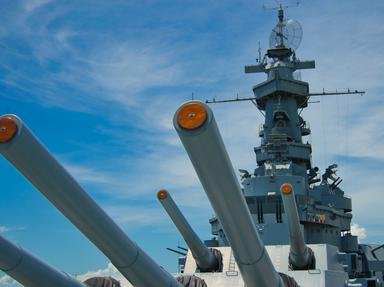Quiz Answer Key and Fun Facts
1. It is January, 1943. The United States Navy needs hands to man its rapidly growing submarine fleet. What was one trait all American submariners had in common?
2. Your name is John Smith; you join the Navy, and finish boot camp. What is the next thing you must do before you become a submariner?
3. If you pass the screening, you'll be sent to the Navy's Submarine School for your initial training. Where is it located?
4. You've made it through Submarine School, and are ready for your first assignment. Where are you likely to serve for most of the war?
5. You receive your orders to the USS Lancefish, a new Balao-class submarine en route to Pearl Harbor. The Navy flies you there to await her arrival. When you report onboard, you begin to learn about your shipmates. How many men made up the crew of a typical WWII submarine?
6. Since you are still a seaman, or non-rated man, the captain urges you to "strike for a rating," or choose a specialty in which you can become a petty officer. You learn that almost half the crew consists of only three ratings. What are they?
7. You decide to strike for Torpedoman, and are assigned to the Forward Torpedo Room, which contains six torpedo tubes and sixteen torpedoes. You learn that you will even have to sleep there. In addition to learning about the intricacies of the Mark XIV torpedo, you learn that you will also have to "qualify in submarines." If you succeed, what will be your reward?
8. Lancefish gets underway, and begins her first war patrol. After stopping at Midway Island to top off fuel, you proceed to your patrol area in the South China Sea. On the way there, you stand lookout watches. What are you are you especially watchful for as you scan the horizon with your binoculars?
9. Since it will take several days to arrive at your patrol area, the captain decides to make good use of the time by drilling Lancefish's crew. You are standing lookout when you hear the diving alarm - "Uh-oo-gah! Uh-oo-guh!" and the order, "Dive! Dive!" You scramble down from your post high among the periscope shears, and slide down the ladder leading to the control room as the last man is closing the hatch. It takes Lancefish one minute and 12 seconds to go from the surface to periscope depth. Would this time make the captain happy?
10. Between learning your duties as a Torpedoman, trying to qualify in submarines, standing watches, and participating in drills, you are one tired sailor by the time you reach your patrol area a week later. By this time, you have learned that there is one perk of submarine duty that no one had told you about. What is it?
11. After two weeks of uneventful patrolling, you are finally getting used to submarine life. Then one day, as you are drinking coffee in the crew's mess, it happens. "Battle Stations." You put down your coffee and rush to the Forward Torpedo Room. Shutting and dogging the watertight door behind you, you prepare for your first action. Over a dozen men are crowded into the compartment; you try to stay out of the way while the more experienced hands man the firing station. Lancefish launches four torpedoes towards a small Japanese convoy, escorted by two destroyers. You wait, your body tense, but nothing happens. Finally the phone talker says, "Two missed ahead, two hit the freighter, but both were duds." Duds? Were malfunctioning torpedoes a common occurrence?
12. Your action is not yet over. Suddenly you hear a distinct "ping." The Japanese escorts have spotted you with their sonar and are closing in for the kill. You hear the orders, "Take her to 300 feet! Rig for silent running. Rig for depth charge." What is your best tactic to avoid being sunk by a depth charge attack?
13. You lie in your bunk as the Japanese destroyer drops two dozen depth charges in a vain attempt to bring an end to Lancefish's career. You can hear a clicking noise as they arm, and hear and feel the violent explosions as they shake your submarine. But after a couple of hours the destroyer loses interest and pulls away. The patrol continues. The Lancefish makes four more attacks, and her luck improves; she sinks a Japanese freighter and an oiler. The veterans tell you that you will receive recognition for Lancefish's achievement. How?
14. After 52 grueling days at sea, Lancefish has expended all of her torpedoes, and the captain announces it is time to "return to the barn," or head back to Pearl Harbor. On the way back, you complete your qualification in submarines and learn that you have been promoted from seaman to Torpedoman Third Class. After docking at the submarine base in Pearl Harbor, you are given several weeks off to recuperate. You also get in line to receive your pay from the disbursing officer. What was true about a submariner's pay during WWII?
15. After checking in at the Royal Hawaiian, you head for downtown Honolulu and the tailor's shop, and have your dolphins and new rating badge sewn onto your dress white uniform. Then you head to a bar on Hotel Street to have a few beers and inquire about your friend, Joe Jones, who was with you at Submarine School. He was assigned to the USS Pompano (SS-181). Another sailor tells you that Pompano is on "eternal patrol." What does that mean?
Source: Author
daver852
This quiz was reviewed by FunTrivia editor
bloomsby before going online.
Any errors found in FunTrivia content are routinely corrected through our feedback system.

